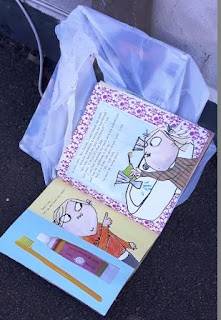During our holiday week, we watched a number of DVDs that we had picked up cheaply in a charity shop. One of them was the film version of The Day of the Triffids released in 1962. In this review I am going to include some spoilers for both the film and the book version of The Day of the Triffids, so if you haven't seen this or read the book and you want to, then stop reading now!
 |
| The DVD cover |
I am a big fan of John Wyndham's writing and have re-read The Day of the Triffids a few times. He was an elegant writer with a very lean approach to storytelling. There was no unnecessary descriptive text in his work. He got on with the action. When there is exposition in his books, he handles it all very matter-of-fact and tells the reader what the reader needs to know at that point. Sometimes there are hints of the darkness ahead - because there is always darkness ahead - but he doesn't overdo it.
This film was produced about ten years after The Day of the Triffids was first published. And they butchered the book as they turned it into a screenplay. That would be my biggest gripe about it.
I don't really expect much from a 1960s monster movie. The direction was very stagey and unnatural. Sometimes that doesn't matter in a film, but this was clunky. The script was poor. Characters would say things then other characters would say things and what they said didn't necessarily seem to follow on. There was one actress who seemed to only be in the film to scream theatrically when she saw a triffid. (That annoyed me particularly because John Wyndham didn't write his female characters like that - in his books women were usually resourceful, brave, clever and funny. They didn't just stand there screaming.)
The film did some scenes well, particularly cutaway scenes on a cruise liner with everyone struck blind, passengers and crew, and the same with a passenger airplane that was doomed to crash. Those bits were suitably chilling. The rest, not so much.
It's possible to do an adaptation that sticks to the story. The BBC version from 2009 (which I blogged about here but haven't seen since it was broadcast) was much closer to the book. This film felt like it had been adapted by someone who hadn't really read or understood the book, been given a list of principal characters and told to get on with it.
The only part that was really close to the book was the opening scenes that established the lead character, Bill, in a hospital bed with his eyes bandaged while everyone else looks at the "meteor" lightshow, and then the following morning when he removes his dressings and discovers everyone else has gone blind.
The triffids themselves were only mildly menacing monsters in this film. But they are meant to be only mildly menacing because they're plants. They don't run after you even though they can move. It's the ones lurking, hidden in the bushes that get you with their deadly stings. In the first third of the film, the director made good use of not showing the entire monster, just a slimy root on a stair, or a flower betraying the presence of a triffid hiding in with other greenery. But then they became slowly-advancing rubbery aggressors and it was hard to take them seriously.
There is a great visual sequence where Bill rigs up a flame thrower and torches massed ranks of triffids being held at bay by an electric fence, which is an event that was sort of lifted from the book. It's surprisingly violent, watching the triffids burn. But the action had been so staccato up to that point that the big set piece didn't have any tension to it. The final denouement - with the discovery that seawater could be used to turn triffids into puddles of oozing slime - wasn't part of the book at all.
Where this film really went wrong was making the triffids space aliens carried on meteors. That's not in the book. Triffids are discovered in an African rainforest and then deliberately farmed for their highly versatile oil. In fact, that's why Bill ends up in hospital having eye surgery in the book - on a visit to a triffid farm one of the plants tries to sting him and some of the venom ends up in his eyes.
So, the triffids don't arrive on meteors. And, as a further twist, the lights in the sky aren't actually meteors at all! What's revealed in the book is that a satellite had been launched that was a weapon designed to cause blindness, and it had malfunctioned.
The idea of space-borne weaponry was incredibly forward-thinking in 1951. It was a few years before the first orbiting satellites were launched. It's probably the scariest part of the story - and it's the bit that gets left out of adaptations!
Because the point of The Day of the Triffids is that humans are prone to exploiting very dangerous natural resources, and are very resourceful at thinking up ways to kill other humans, and if something went wrong it could get very nasty. Basically, John Wyndham's message is that we don't need an alien invasion to doom us. Humans are very capable of dooming ourselves.
John Wyndham did write an alien invasion novel a couple of years later. The Kraken Wakes is an equally vivid story, and possibly edges The Day of the Triffids in both concept and delivery. It hasn't ever been made into a film, but given how film-makers missed the point of the triffids, maybe that's a blessing.







































